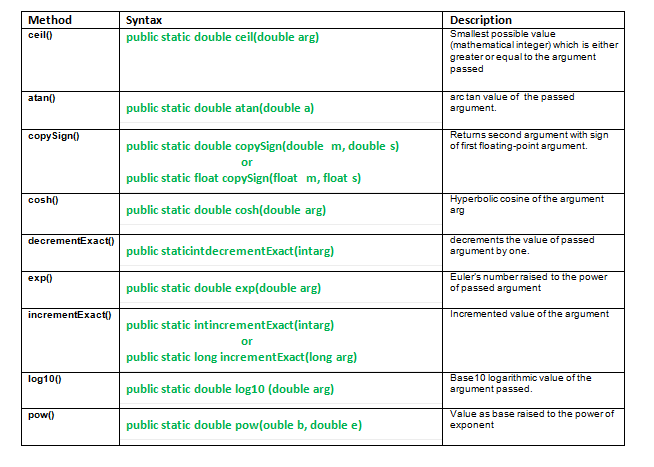Java.math 类及其方法 |设置 3
Java.math 类及其方法 |设置 1
Java.math 类及其方法 |设置 2

- ceil() : Java.math.ceil(double a)方法返回大于或等于传递的参数的最小可能值。返回值是一个数学整数。特例 :
- 如果返回的值已经是一个数学整数,结果是一样的。
- 如果传递的参数是 NaN 或无穷大或零,则结果相同。
- 如果传递的参数小于零但大于 -1.0,则结果为负零
句法:
public static double ceil(double arg)
Parameters:
arg - the argument value
Returns:
smallest possible value(mathematical integer)
which is either greater or equal to the argument passed- atan() : Java.math.atan()方法返回方法参数值的反正切。返回的角度在 -pi/2 到 pi/2 的范围内。
arc tan 是传递的参数的逆 tan。
atan(arg) = tan arg 的倒数
特例 :- 如果传递的参数为 NaN 或其绝对值 > 1,则结果为 NaN。
- 如果参数为零,则结果为零。
句法:
public static double atan(double a)
Parameters:
a - the argument whose arc tangent value we need.
argument is taken as radian
Returns:
arc tan value of the argument.- copySign() : Java.math.copySign()方法返回第一个浮点参数,但具有第二个参数的符号。
句法:
public static double copySign(double m, double s)
or
public static float copySign(float m, float s)
Parameters:
m - magnitude
s - sign
Returns:
returns second argument with sign of first floating-point argument.Java代码解释了 Math 类中的 atan()、ceil()、copySign() 方法。
Java
// Java program explaining Math class methods
// atan(), ceil(), copySign()
import java.math.*;
public class NewClass
{
public static void main(String[] args)
{
// Use of atan() method
double Atani = Math.atan(0);
System.out.println("atan value of Atani : "+Atani);
double x = Math.PI/2;
// Use of toRadian() method
x = Math.toRadians(x);
double Atanj = Math.atan(x);
System.out.println("atan value of Atanj : "+Atanj);
System.out.println("");
// Use of ceil() method
double val = 15.34 ,ceilval;
ceilval = Math.ceil(val);
System.out.println("ceil value of val : "+ceilval);
System.out.println("");
double dblMag = val;
double dblSign1 = 3;
double dblSign2 = -3;
// Use of copySign() method
double result1 = Math.copySign(dblMag,dblSign1);
System.out.println("copySign1 : "+result1);
double result2 = Math.copySign(dblMag,dblSign2);
System.out.println("copySign2 : "+result2);
}
}Java
// Java program explaining Math class methods
// exp(), decrementExact(), cosh()
import java.math.*;
public class NewClass
{
public static void main(String[] args)
{
// Use of cosh() method
double value = 2;
double coshValue = Math.cosh(value);
System.out.println("Hyperbolic Cosine of " + coshValue);
System.out.println("");
// Use of decrementExact() method
int result = Math.decrementExact(3051);
System.out.println("Use of decrementExact() : " + result);
System.out.println("");
// Use of exp() method
// declare the exponent to be used
double exponent = 34;
// raise e to exponent declared
double expVal = Math.exp(exponent);
System.out.println("Value of exp : "+ expVal);
}
}Java
// Java program explaining MATH class methods
// incrementExact(), log10(), pow()
import java.lang.*;
public class NewClass
{
public static void main(String[] args)
{
// Use of incrementExact() method
int f1 = 30, f2 = -56;
f1 =Math.incrementExact(f1);
System.out.println("Incremented value of f1 : "+f1);
f2 =Math.incrementExact(f2);
System.out.println("Incremented value of f2 : "+f2);
System.out.println("");
// Use of log10() method
double value = 10;
double logValue = Math.log10(value);
System.out.println("Log10 value of 10 : "+logValue);
System.out.println("");
// Use of pow() method
double b = 10, e = 2;
double power = Math.pow(b,e);
System.out.println("Use of pow() : "+power);
}
}输出:
atan value of Atani : 0.0
atan value of Atanj : 0.0274087022410345
ceil value of val : 16.0
copySign1 : 15.34
copySign2 : -15.34- cosh() : Java.math.cosh()方法返回所传递参数的双曲余弦值。
特别案例 :- 如果参数为 NaN,则结果为 NaN。
- 如果参数为零,则结果为 1.0。
- 如果参数是无限的,则结果是 +ve infinity。
句法:
public static double cosh(double arg)
Parameters:
arg - The number whose hyperbolic cosine is to be returned.
Returns:
the hyperbolic cosine of the argument arg.- decrementExact() : Java.math.decrementExact()方法将传递参数的值减一。
句法:
public static int decrementExact(int arg)
or
public static long decrementExact(long arg)
Parameters:
arg - argument passed.
Returns:
return argument decremented by one.
Throws:
Exception if the result overflows long or int datatype, according to the
argumented data type.- exp() : Java.math.exp(double arg)方法返回欧拉数提高到双参数的幂。
重要案例:- 如果参数为 NaN,则结果为 NaN。
- 如果参数是 +ve infinity,则结果是 +ve infinity。
- 结果是 +ve 零,如果参数是 -ve 无穷大。
句法:
public static double exp(double arg)
Parameters:
arg - argument passed.
Returns:
Euler’s number raised to the power of passed argumentJava代码解释了 Math 类中的 exp()、decrementExact()、cosh() 方法。
Java
// Java program explaining Math class methods
// exp(), decrementExact(), cosh()
import java.math.*;
public class NewClass
{
public static void main(String[] args)
{
// Use of cosh() method
double value = 2;
double coshValue = Math.cosh(value);
System.out.println("Hyperbolic Cosine of " + coshValue);
System.out.println("");
// Use of decrementExact() method
int result = Math.decrementExact(3051);
System.out.println("Use of decrementExact() : " + result);
System.out.println("");
// Use of exp() method
// declare the exponent to be used
double exponent = 34;
// raise e to exponent declared
double expVal = Math.exp(exponent);
System.out.println("Value of exp : "+ expVal);
}
}
输出:
Using addExact() : 9
acos value of Asini : NaN
acos value of Asinj : 0.054858647341251204
cube root : 6.0 - incrementExact() : Java.math.incrementExact()方法通过增加它的值来返回参数。
Syntax:
public static int incrementExact(int arg)
or
public static long incrementExact(long arg)
Parameters:
arg - the argument
Returns:
incremented value of the argument- log10() : Java.math.log10()方法返回传递参数的以 10 为底的对数值。
Syntax:
public static double log(double arg)
Parameters:
arg - argument passed.
Returns:
base10 logarithmic value of the argument passed.- pow() : Java.math.pow(double b, double e)方法返回值为b e
Syntax:
public static double pow(double b,double e)
Parameters:
b : base
e : exponent
Returns:
value as baseexponent解释 Math 类中的 incrementExact()、log10()、pow() 方法的Java代码。
Java
// Java program explaining MATH class methods
// incrementExact(), log10(), pow()
import java.lang.*;
public class NewClass
{
public static void main(String[] args)
{
// Use of incrementExact() method
int f1 = 30, f2 = -56;
f1 =Math.incrementExact(f1);
System.out.println("Incremented value of f1 : "+f1);
f2 =Math.incrementExact(f2);
System.out.println("Incremented value of f2 : "+f2);
System.out.println("");
// Use of log10() method
double value = 10;
double logValue = Math.log10(value);
System.out.println("Log10 value of 10 : "+logValue);
System.out.println("");
// Use of pow() method
double b = 10, e = 2;
double power = Math.pow(b,e);
System.out.println("Use of pow() : "+power);
}
}
输出:
Incremented value of f1 : 31
Incremented value of f2 : -55
Log10 value of 10 : 1.0
Use of pow() : 100.0注意:不需要创建新对象来调用这些方法,因为上面讨论的 Math 类方法是静态的。